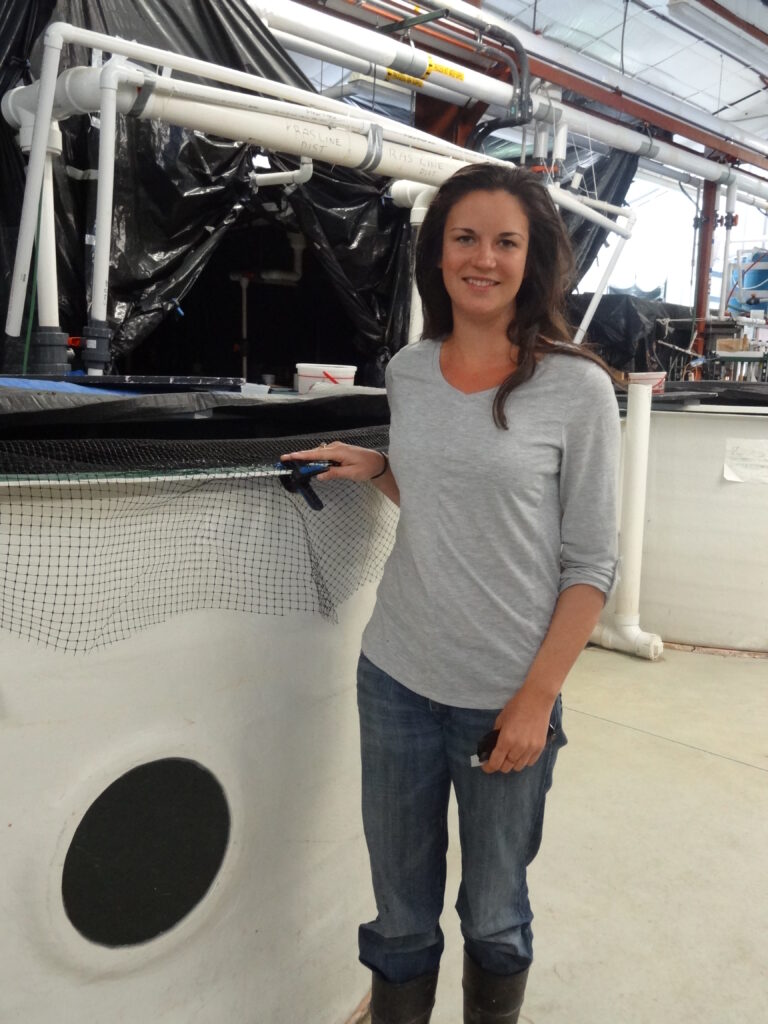By Eva Ryan, University of Wisconsin-Madison
The next specialist I interviewed in celebration of Wisconsin Sea Grant’s 50th anniversary was Emma Wiermaa, aquaculture and education outreach specialist. Together, we discussed details of Wiermaa’s specialty that have changed and details she hopes to see change in the future.
Wiermaa is stationed at the University of Wisconsin-Stevens Point Northern Aquaculture Demonstration Facility (NADF). Her position is in collaboration between Wisconsin Sea Grant and the University of Wisconsin-Stevens Point. NADF is a research and demonstration facility for freshwater finfish that may be used for a variety of food fish, baitfish or conservation species projects. The facility also partners with various organizations, private, public and tribal, looking to engage in sustainable aquaculture.

Emma Wiermaa at the Northern Aquaculture Demonstration Facility. Image credit: Marie Zhuikov, Wisconsin Sea Grant
“My job is to take the research that we’re doing and convert it into a way that’s understandable and usable for various groups,” said Wiermaa. One of Wiermaa’s key audiences are K-12 students. Her duty involves effectively engaging and educating these children on what aquaculture is and why it is important, not only for educational purposes but also as a career pathway.
Though Wiermaa has only been working for the aquaculture industry for eight years, she said, “In the past 50 years from what I’ve seen, there seems to be a lot more interest in the growth of recirculating aquaculture systems (RAS).” Essentially, RAS have the potential to create the best possible circumstances to optimize fish growth throughout the year. This includes control of various environmental factors such as temperature, flow rates, lighting, water quality and biosecurity. She said that temperature control is especially important in our Midwest climate for species that require warmer temperatures for optimum growth, such as the walleye.
“We’re part of these national groups that want to see this (RAS) succeed, and they’re (the NADF) doing it in a sustainable way. They’re thinking about water reuse, effluent (water leaving the site) and optimum control of the fish-rearing environment.”
Not wasting any time in looking forward to the next 50 years of aquaculture, Wiermaa expressed her hope to continue supporting local and sustainable aquaculture, not only aquaculture research but also the farmers working hard to support local communities while providing fresh and local fish. “It is important for consumers to know that purchasing fish and seafood raised in the U.S. ensures a safe, healthy and tastefully fresh option that supports local jobs and communities,” she said.
To help achieve this, Wiermaa notes that misconceptions about the aquaculture industry need to be addressed to erase any stigma. “We need the trust, we need the support, and we need the research,” Wiermaa said.
Wiermaa mentioned one specific detail: farmers know better than anyone that fish are sensitive animals that require a healthy environment with good water quality in order to survive on a daily basis. Farmers must ensure clean living conditions for these fish because otherwise, the fish would not survive. She stressed that maintaining honesty in research and information is essential in eliminating misconceptions.
To cap off the interview, Wiermaa expressed her appreciation for Wisconsin Sea Grant in supporting aquaculture research and sustainable practices. She said, “I think that’s why everyone who works at the facility is so passionate about it because we’re doing cutting-edge research that really helps our partners. It’s all about partnerships and helping to advance sustainable aquaculture.”


